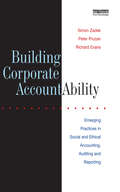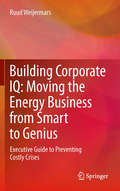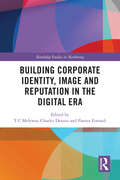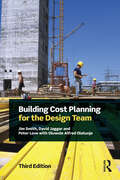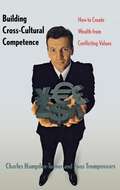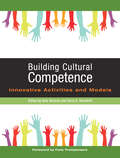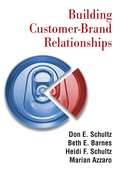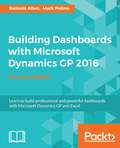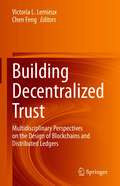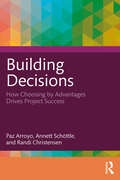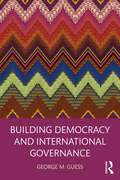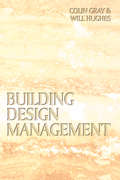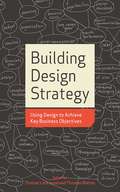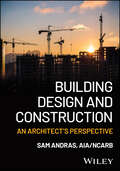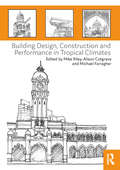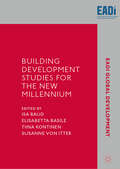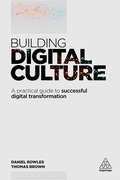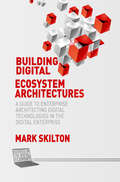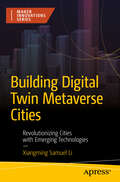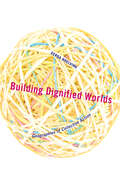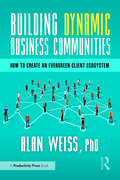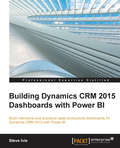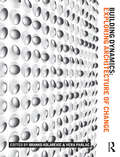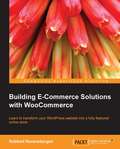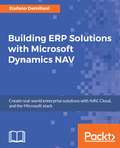- Table View
- List View
Building Corporate Accountability: Emerging Practice in Social and Ethical Accounting and Auditing
by Richard Evans Simon Zadek Peter PruzanThe practice of social and ethical accounting is emerging as a key tool for companies in the 1990s in response to calls for greater transparency and accountability to different stakeholders, and as a means for managing companies in increasingly complex situations where social and environmental issues are significant in securing business success. This is the first book to address the practice of social and ethical accounting, auditing and reporting, and its implications for the development of corporate social, ethical and environmental responsibility. It includes ten case studies, as well as an historical overview of the development of social and ethical accounting and reporting. The editors introduce a methodological framework that allows emerging practice worldwide to be analysed, understood and improved; and the case studies are written by the practitioners, giving insight into the experiences described. This innovative book, written by internationally acknowledged leaders in the field, will be of enormous value to business managers, particularly those with responsibility for corporate affairs, human resources, environmental management, financial management, or planning. It will also be a useful text for business students.
Building Corporate IQ – Moving the Energy Business from Smart to Genius: Executive Guide to Preventing Costly Crises
by Ruud WeijermarsBuilding Corporate IQ - Moving the Energy Business from Smart to Genius gives a clear outline of organizational intelligence and provides a framework for practitioners of good leadership. The synthesis starts with an overview of the fundamental skills and competencies mastered by leaders and team members in organizations. Building Corporate IQ - Moving the Energy Business from Smart to Genius also includes a corporate IQ test that is designed to help leaders gain insight into how their organization can stay at the competitive frontier. Illustrated with case studies from the energy sector, Building Corporate IQ - Moving the Energy Business from Smart to Genius explains the guiding principles of organizational learning, with the goal of developing better organizational intelligence. It is intended as an indispensable guide for managers at all levels to help them meet and recognize new challenges in the corporate innovation process. "For the third millennium, with the increase in depersonalized electronic communication, business leaders, especially in the energy industry, must quickly develop organizational intelligence in their organizations to survive. This book sets out the modus operandi." Crispian McCredie, former Managing Director and Publisher, The Petroleum Economist "MBA graduates and seasoned professionals will find this executive guide a powerful reference during their careers." Ken Graham, former Head Global Leadership Development, Shell
Building Corporate Identity, Image and Reputation in the Digital Era (Routledge Studies in Marketing)
by T C Melewar, Charles Dennis and Pantea ForoudiBrands – corporate, products, service – today are collectively defined by their customers, deriving from personal experiences and word of mouth. This book acts as a forum for examining current and future trends in corporate branding, identity, image and reputation. Recognising the complexity and plurality at the heart of the corporate branding discipline, this book fills a gap in the literature by posing a number of original research questions on the intrinsic nature of corporate branding ideas from corporate (external) and organisation (internal) identity perspectives as they relate to brand management, corporate reputation, marketing communications, social media, smart technology, experiential and sensory marketing. It incorporates current thinking and developments by both multidisciplinary academics and practitioners, combining a comprehensive theoretical foundation with practical insights. The text will serve as an important resource for the marketing, identity and brand practitioners requiring more than anecdotal evidence on the structure and operation of stakeholders communication in different geographical areas. It determines current practices and researches in diverse areas, regions and commercial and non-commercial sectors across the world. The book provides scholars, researchers and postgraduate students in business and marketing with a comprehensive treatment of the nature of relationships between companies, brands and stakeholders in different areas and regions of the world.
Building Cost Planning for the Design Team
by Jim Smith D M Jaggar Peter LoveCost management of all building projects has become increasingly important as clients in the public and private sector demand the highest quality cost planning services with accurate budgeting and cost control. All members of the design team must integrate their activities to ensure that a high quality project is delivered on time and within budget. This book considers building cost planning and cost control from the client and the design team's perspective, where all decisions whether concerned with design, cost, quality, time, value or sustainability are taken as being interrelated. The latest Royal Institute of British Architects (RIBA) Plan of Work and the New Rules of Measurement for Early Stage Estimating and Cost Planning issued by the Royal Institution of Chartered Surveyors (RICS) have been incorporated into this new text. The book follows the building design cost planning process from the crucial inception stages and then through all the design stages to the completion of the technical design, contract documentation and the tender. It provides a template for good cost planning practice. An essential addition to this third edition is the introduction of integrated design and documentation processes captured in building Information modelling (BIM), on-line cost databases and computerised methods of cost planning. The integrated approaches are explained and provide vital information and knowledge for practitioners involved in building projects. All stakeholders involved in development and design and client teams in public and private sector policy making and implementation need to understand the new approaches to design management processes and how cost planning and design approaches are adapting to using the new technology in practice. The interactive style, using in-text and review questions makes this ideal for students and practitioners alike in property, architecture, construction economics, construction management, real estate, engineering, facilities management and project management.
Building Cross-Cultural Competence: How to Create Wealth from Conflicting Values
by David Lewis Charles Hampden-Turner Fons TrompenaarsBased on 14 years of research involving nearly 50,000 managerial respondents and on the authors' extensive experience in international business, this book uses humor, cartoons, and numerous business examples to show managers how to reconcile cultural differences in the workplace.
Building Cultural Competence: Innovative Activities and Models
by Darla K. Deardorff Kate BerardoFor HR directors, corporate trainers, college administrators, diversity trainers and study abroad educators, this book provides a cutting-edge framework and an innovative collection of ready-to-use tools and activities to help build cultural competence—from the basics of understanding core concepts of culture to the complex work of negotiating identity and resolving cultural differences.Building Cultural Competence presents the latest work in the intercultural field and provides step-by-step instructions for how to effectively work with the new models, frameworks, and exercises for building learners’ cultural competence. Featuring fresh activities and tools from experienced coaches, trainers, and facilitators from around the globe, this collection of over 50 easy-to-use activities and models has been used successfully worldwide in settings that range from Fortune 500 corporations to the World Bank, non-profits, and universities. Learn updates on classic models like the DIE (Description, Interpretation, Evaluation) framework and the U-Curve model of adjustment. Engage in new exercises to help build intercultural competence, using the practical step-by-step guidance on how to effectively facilitate these activities. Stay relevant and have positive impact with clients, organizations, and students with these well-organized, easy-to-implement, and high impact collection of frameworks, models, and activities.The new, research-based models work for developing cultural competence in any environment, and for designing effective cultural competence courses. Education abroad administrators will be able to use these activities in their pre- departure orientations for students going abroad. Corporate human resource professionals will find these activities invaluable in cultural competence building programs.
Building Customer-brand Relationships
by Marian Azzaro Don E. Schultz Beth E. Barnes Heidi F. SchultzAlmost every advertising, promotion, or marketing communications textbook is based on an inside-out approach, focusing on what the marketer wants to communicate to customers and prospects. This text takes a different view - that the marketer and the customer build the ongoing brand value together. Rather than the marketer trying to 'sell', the role of the marketer is to help customer buy. To do that, a customer view is vital and customer insight is essential. Customer insights allow the marketer to understand which audiences are important for a product, what delivery forms are appropriate, and what type of content is beneficial. "Building Customer-Brand Relationships" is themed around the four key elements marketing communicators use in developing programs - audiences, brands, delivery, and content - but provides an innovative approach to marketing communications in the 'push-pull' marketplace that combines traditional outbound communications (advertising, sales promotion, direct marketing, and PR) with the inbound or 'pull' media of Internet, mobile communications, social networks, and more. Its 'customer-centric' media planning approach covers media decision before dealing with creative development, and emphasizes measurement and accountability. The text's concepts have been used successfully around the world, and can be adapted and adjusted to any type of product or service.
Building Dashboards with Microsoft Dynamics GP 2016 - Second Edition
by Mark Polino Belinda AllenLearn to build professional and powerful dashboards with Microsoft Dynamics GP and Excel About This Book • This book provides a core foundation for you to understand the ever-changing Microsoft Power BI • Through this book, you'll understand how data flows and is secured between Microsoft Dynamics GP and Microsoft Excel • You'll see how to create amazing dashboards using various tools such as Excel 2016, Power BI, Jet Express, and more Who This Book Is For This book is geared up for analysts and accountants keen on building and maintaining professional dashboards with Microsoft Excel 2016 for Microsoft Dynamics GP 2016 data, and building financials with visuals using the New Jet Reports Express Tool for Dynamics GP. An introduction is provided for those who want to maintain dashboards in Microsoft Power BI. What You Will Learn • Use GP Data in Excel 2016 in a meaningful way • Build basic financial statements using Jet Reporting Express, including visualizations • Understand the foundation of Power BI and its components • Get and maintain data from Dynamics GP in Power BI • Find out how to use the Power BI Query Editor (the Get and Transform feature in Excel 2016) • Format basic visualizations to get better insights • Understand Jet Reports Express, which is used to create basic financial statements • Use the new Dynamics GP features, such as OData and adding Power BI tiles on the home page In Detail Microsoft Dynamics GP is a complete ERP solution that is extremely beneficial for small to midsize organizations in helping them grow exponentially. The book shows you in detail how to build great-looking dashboards with Microsoft Dynamics GP that enhance a company's decision-making processes. This guide will take you from the basics of setting up and deploying to creating secure, refreshable Excel reports. Using a whole host of tools available within Microsoft Dynamics GP and Excel, this tutorial will show you how to visualize your data using simple conditional formatting techniques and easy-to-read charts, and allow you to make your data interactive with slicers. We will also cover core topics such as Business Analyzer, Microsoft SQL Reporting services reports, BI360, and more. You will find out to use Power BI, share and refresh data and dashboards in Power BI, and use Power BI Query Editor. By the end of this book, you will have all the information required to build interactive dashboards using Dynamics GP. Style and approach The book takes a step-by-step approach and contains real-world examples that provide the building blocks to create engaging dashboards. This practical guide is all about doing. Get your data, open up Excel, and go!
Building Decentralized Trust: Multidisciplinary Perspectives on the Design of Blockchains and Distributed Ledgers
by Victoria L. Lemieux Chen FengThis volume brings together a multidisciplinary group of scholars from diverse fields including computer science, engineering, archival science, law, business, psychology, economics, medicine and more to discuss the trade-offs between different “layers” in designing the use of blockchain/Distributed Ledger Technology (DLT) for social trust, trust in data and records, and trust in systems. Blockchain technology has emerged as a solution to the problem of trust in data and records, as well as trust in social, political and economic institutions, due to its profound potential as a digital trust infrastructure. Blockchain is a DLT in which confirmed and validated sets of transactions are stored in blocks that are chained together to make tampering more difficult and render records immutable. This book is dedicated to exploring and disseminating the latest findings on the relationships between socio-political and economic data, record-keeping, and technical aspects of blockchain.
Building Decisions: How Choosing by Advantages Drives Project Success
by Paz Arroyo Annett Schöttle Randi ChristensenDecision-making is critical. Leaders make decisions daily, often hyper-focusing on cost at the expense of value for society and with negative impacts on the environment and the climate. Project teams are poorly equipped to make decisions and prefer to avoid conflicts instead of having a healthy discussion based on different perspectives. We need to learn ways of making decisions that give better outcomes.Building Decisions presents a framework and practical guidelines for everyday decision-making. The authors introduce the reader to a specific decision-making system, Choosing By Advantages (CBA), and explain the CBA Tabular decision-making method. Providing detailed explanations using relatable examples such as choosing a phone and renovating a kitchen, the book also uses case studies of large construction projects from the authors’ professional careers, including a museum in San Francisco, a tunnel in England, and the main railway station in Munich, to explain the CBA method. These varied examples will help the reader to improve their own decision-making process through critical reflection.Written by three curious experts who founded a research lab focusing on decision-making and want the world to make better decisions. Paz, Annett, and Randi have published dozens of peer-reviewed papers and trained multiple practitioners and engineers on how to make collaborative decisions using CBA. They have designed this book to help professionals, leaders, anyone, and everyone make better and more inclusive decisions and achieve better outcomes.
Building Democracy and International Governance
by George M. GuessEfforts by governments to promote sustained domestic economic development have been mixed. Success depends on many factors including location, geography, climate, external competition, human resources, natural resources, timing, political and governmental institutions, government capacity, implementation, leadership, values—and maybe luck. This complexity means that while development experts can often identify ingredients for success, few can prescribe the specific mix needed by a particular state to achieve sustained development over the long term. In Building Democracy and International Governance, author George M. Guess uses both case studies and careful data analysis to argue that federalist democracy may just be the most responsive, authoritative, and flexible system for nation building, and that there is value in confronting the challenges that lie in exporting federalist democracy abroad. Guess demonstrates the ways in which federation structures provide positive redundancy against failures, flexibility to change course and implement programs and policies, and state legitimacy and strength. Examining twelve wealthy and developing countries from five regions, representing democratic and authoritarian government structures, confederations, and federations, this book will be of interest to those teaching graduate and undergraduate courses in Political Development, Democratization, Federalism, and Comparative Political Economy.
Building Design Management
by Colin Gray Will HughesA practical handbook on the management of building design, this guide explains the processes, roles and responsibilities of those involved in the design of the building, as well as ways to maximise efficiency. Well structured and easy to read, the book includes useful notes and checklists on, for example, how to select a design team and how to organise and plan the design process. The authors are recognised authorities in the field of project management, based at an internationally renowned department. Their book will prove invaluable to both students and practitioners in project management.
Building Design Strategy: Using Design to Achieve Key Business Objectives
by Thomas Lockwood Thomas WaltonHow can design be used to solve business problems? That's the question answered, in many innovative ways, by Building Design Strategy. Mark Dziersk, EunSool Kwon, Arnold Levin, Laura Weiss, and many more top-name contributors share their experience and insights. Topics explore the full range of issues today, including thinking ahead; adapting to challenges; developing tangible strategies; using design to convey ideas; choosing worthwhile projects to help growth; using design to create fiercely loyal customers.
Building Design and Construction: An Architect's Perspective
by Sam AndrasOffers experience-driven guidance on navigating the full building design and construction process Building Design and Construction: An Architect’s Perspective provides the foundational knowledge necessary to lead complex projects with confidence. Drawing on over 40 years of combined experience in both construction and architectural practice, author Sam Andras delivers a comprehensive understanding of how building projects succeed—beginning with a clear grasp of the roles, responsibilities, and collaboration required among all stakeholders. This highly practical resource fills a crucial gap between academic instruction and real-world application—connecting professional principles to actual project experiences through detailed case studies and lessons learned. Rather than simply explaining processes, the author provides a roadmap for decision-making at every stage—from concept to completion. Readers will gain insight into key delivery methodologies, contract structures, and design phases while learning how to evaluate and select the best approaches for each unique project. Throughout the book, practical examples underscore how missteps were corrected, or could have been avoided, through cooperation, collaboration, and shared goals, helping students and professionals alike avoid common pitfalls. With a clear, step-by-step structure and emphasis on collaborative success, Building Design and Construction: An Architect’s Perspective: Features a dedicated “Roadmap to Success” chapter that integrates key lessons from preceding chapters while setting the foundation for the integration and understanding of post-chaptersExplains industry-standard terminology, tools, and documentation to build a shared understanding among project stakeholdersIncludes clearly defined processes for selecting project teams, delivery methods, and contractual frameworksProvides strategic approaches to troubleshooting project challenges, including key aspects of project planning that directly impact long-term project outcomes Addressing both design intent and construction execution to demonstrate how integrated thinking drives project success, Building Design and Construction: An Architect’s Perspective is ideal for architecture, engineering, and construction management students. It is also a valuable reference guide for owners and project managers seeking a working understanding of what drives successful project delivery.
Building Design, Construction and Performance in Tropical Climates
by Mike Riley Alison Cotgrave Michael FarragherThe design, construction and use of buildings in tropical climates pose specific challenges to built environment professionals. This text seeks to capture some of the key issues of technology and practice in the areas of building design, refurbishment, construction and facilities management in tropical regions. Using a consistent chapter structure throughout, and incorporating the latest research findings, this book outlines: the functional requirements of buildings in tropical climates; the challenges associated with the sustainability of the built environment, building form and whole life performance in the context of a tropical setting; the impact of potentially hostile tropical conditions upon building pathology and the durability of components, structure and fabric; the tasks which face those responsible for appraising the design, condition, maintenance and conservation of built heritage in tropical regions; the facilities management issues faced in tropical climates; and the refurbishment, upgrade and renewal of the tropical built environment. The book is ideal as a course text for students of Architecture, Construction, Surveying and FM as well as providing a sound reference for practitioners working in these regions.
Building Development Studies for the New Millennium (EADI Global Development Series)
by Isa Baud Elisabetta Basile Tiina Kontinen Susanne Von ItterThis book brings together multiple critical assessments of the current state and future visions of global development studies. It examines how the field engages with new paradigms and narratives, methodologies and scientific impact, and perspectives from the Global South. The authors focus on social and democratic transformation, inclusive development and global environmental issues, and implications for research practices. Leading academics provide an excellent overview of recent insights for post-graduate students and scholars in these research areas.
Building Digital Culture: A Practical Guide to Successful Digital Transformation
by Thomas Brown Daniel RowlesBuilding Digital Culture aims to answer a simple question: How can organisations succeed when the environment they operate in is changing so quickly? The last thing businesses need today is a digital strategy. Instead, their strategy needs to be fit for our fast-changing digital world, where businesses have more data than they know what to do with, a media landscape that's exploded in size and complexity, the risk of a new disruption around every corner, and only one certainty: that this change won't let up.Building Digital Culture doesn't address whether or not you should advertise on Facebook or invest in virtual reality. It doesn't seek to unearth a silver bullet to make digital investments a sure-thing. It steps back from the hype, and argues that whatever digital might mean for your business, if you don't create a digital culture you'll most likely fail, or at least fall short of what you want to achieve.Daniel Rowles and Thomas Brown combine more than 30 years of experience at the forefront of marketing and digital developments to help you to navigate from being a business that tolerates or acts digital, to one that truly is digital.Building Digital Culture is based on more than 200 hours of research, candid interviews and contributions from senior leaders at a diverse range of brands including Twitter, Made.com, Tech London Advocates, Deloitte, HSBC, Reckitt Benckiser, Ladbrokes, Direct Line Group, The Metropolitan Police, Zurich Insurance and many more.
Building Digital Ecosystem Architectures: A Guide to Enterprise Architecting Digital Technologies in the Digital Enterprise (Business in the Digital Economy)
by Mark SkiltonThe design of digital solutions has become a pressing concern for practitioners faced with a plethora of technology impacting their business. From cloud computing to social networks, mobile computing and big data, to the emerging of Internet of things, all of which are changing how enterprise products, services, rooms and buildings are connected to the wider ecosystem of networks and services. This book defines digital ecosystems with examples from real industry cases and explores how enterprise architecture is evolving to enable physical and virtual, social, and material object collaboration and experience. The key topics covered include:Concepts of digitizationTypes of technological ecosystemsArchitecting digital workspaces Principles of architecture design Examples architecting digital business models Examples of digital design patterns Methods of monetizationConclusions
Building Digital Twin Metaverse Cities: Revolutionizing Cities with Emerging Technologies (Maker Innovations Series)
by Xiangming Samuel LiWhy do we need to live in a smart city? Rapid urbanization causes compelling city problems worldwide, such as housing, traffic, schooling, healthcare, employment, and pollution. Numerous smart-city scholars and practitioners have attempted to tackle these problems but lack an integrated approach and practical implementation tools to solve them. This book explains how to build digital twin metaverse cities aimed to accelerate urban digital transformation through emerging technologies. You’ll start by identifying a problem statement, designing a novel digital twin metaverse architecture, reviewing emerging technologies as building blocks and showcasing interesting applications. You’ll then review state-of-the-art digital twin metaverse development tools and present readers with interesting engineering prototypes of my proposed digital twin smart cities. Finally, you’ll discover how to avoid some management pitfalls during the construction of innovative smart cities, including project management, change management, leadership skills, and modern management information systems. With Building Digital Twin Metaverse Cities you’ll work with a novel architectural design and use the latest technologies as building blocks to construct smart cities of your own. What You'll Learn Explore complex issues arising from rapid urbanization. Discover how emerging technologies like 5G, IoT, and AI can solve urban problems. Master the digital twinning process powered by the Data Analytics Flywheel. Explore core and enabling technologies shaping Digital Twin Metaverse Cities. Gain hands-on experience with development tools and prototypes for smart city applications. Who This Book Is For Professionals who want to learn emerging technologies and digital twin metaverse development tools to construct innovative smart cities to solve the current pressing urbanization problems. General readers like city residents and government officials worldwide, who are suffering from the growing pains of rapid urbanization and looking for effective smart city solutions using new technologies and methodology. Smart city researchers and college students wanting to build smart projects for urban digital transformation and smart Xs (everything).
Building Dignified Worlds: Geographies of Collective Action (Diverse Economies and Livable Worlds #1)
by Gerda RoelvinkBuilding Dignified Worlds examines how contemporary collectives are designing alternative economies. Contemporary collectives differ markedly from previous groups associated with revolutionary politics. Instead of assembling large groups of workers around labor issues, these new collectives creatively arrange diverse peoples, animals, natural environments, and technologies around economic concerns. Like older forms of leftist organizing, these collectives seek to bring about change. However, rather than working to overthrow and replace an underlying capitalist system with an equally totalizing alternative like socialism, they experiment with new forms of economic life. This book explores how socially and politically concerned groups actually establish alternative economies.Building Dignified Worlds investigates social movements that do not simply protest but actively forge functional alternatives. The market model described by many scholars and activists as the enemy of these recent social movements rarely exists in today&’s world. As Gerda Roelvink notes, current markets are better conceptualized as dynamic social networks open to intervention by innovative social movements. Radical scholars have theorized social transformation as a performative act. They have provided extensive analysis of how discourse shapes the world through language and is materialized in bodies and practices. Until now, though, little has been written about the geographical nature of collective associations &“performing&” new worlds.Roelvink takes actor network and performativity theories of action as starting points for thinking about how contemporary collectives bring the new into being. This approach enables an understanding of how collectives initiate change and begins to map the forces through which they operate. Roelvink&’s work reveals, in particular, how the relational and geographical nature of performative action is central to the ways in which hybrid collectives strive to create alternative economies.
Building Dynamic Business Communities: How to Create an Evergreen Client Ecosystem
by Alan WeissThis book is based on the author’s lengthy experience in creating communities and helping organizations and individuals thereby providing for evangelism and sustained growth. The result is dynamic marketing and sales at low, or no, cost of acquisition. Thus, communities are powerful sources for business owners, executives, and entrepreneurs. The research and literature supporting communities and the power of referral, peer-level influence, and normative buying pressures is enormous. This is not an internet-based or “pyramid marketing” initiative, which is based on a zero-sum game and is unethical or illegal. These communities are both “live” and remote and become perpetual-motion sales machines. Most organizations have the raw materials for successful communities, but they don’t realize it, nor do they know how to go about creating them.This work is the remedy. The author believes that many people are still “lonely” and isolated post-pandemic with remote work or hybrid work. Communities can embrace these people to build camaraderie and higher performance. The key benefits include gaining value for merely bringing people together who normally would never have met; providing viral marketing among members, which is effective 24/7; easily creating global communities to expand business; and dramatically building brands. Essentially, this book will enable the reader to use over a dozen pragmatic, sequential steps to organize resources, publicize, gain members, provide instant value, and assemble critical mass for the community to continually add members and perpetuate itself in “The chain reaction of attraction”®.
Building Dynamics CRM 2015 Dashboards with Power BI
by Steve IvieBuild interactive and analytical sales productivity dashboards for Dynamics CRM 2015 with Power BI About This Book * Create Dynamics CRM reports using Power BI for Office 365 and Power BI Designer * Discover best practices to build and deploy these dashboards to Power BI sites and Dynamics CRM 2015 * Learn how to extend dashboard to mobile iPad and Surface Power BI apps Who This Book Is For This book is intended for all Dynamics CRM 2015 users--administrators, managers, business analysts, or report writers who are new to creating dashboards using Power BI and Dynamics CRM. It would be helpful to have a basic knowledge of the Dynamics CRM 2015 platform, but no prior experience is required. What You Will Learn * Organize and consolidate Dynamics CRM 2015 datasets * Add summaries and visualizations using charts and maps * Enhance data clarity with filters, slicers, timelines * Improve analysis by joining other data sources * Deploy and present the dashboard to Power BI for Office 365 site * Use the advanced Q/A functionality with Power BI to query data in the dashboard graphs and charts * Connect the dashboards to Dynamics CRM 2015 * Extend functionality with Power BI mobile apps In Detail Dynamics CRM 2015 holds a wealth of information about customers and the sales pipeline, but sometimes leaves users with basic end-user reporting and dashboard options. Power BI is a great new tool for analyzing and presenting data, giving us the ability to dig deeper into the information. With the increased requests for real-time sales analytics, Power BI when connected to Dynamics CRM offers a self-service approach to build, shape, and present data through an easy-to-use interface. The set of features within Power BI will give all users a tool to generate real-time sales productivity reports and dashboards to enhance their sales performance. This book will provide you with the skills you need to learn how to build and present Dynamics CRM 2015 sales dashboards using Power BI. It follows a step-by-step process to build an interactive dashboard by organizing and consolidating datasets, improving the look and feel of graphs, charts, and maps, and enhancing data clarity with filters and slicers. By sequentially working through the steps in each chapter, you will learn how to use the Power BI Q/A functionality to query data in the dashboard, extend the dashboards to the mobile apps for the iPad and Surface, and leverage the pre-built workbook template provided by Microsoft for Dynamic CRM 2015 sales, service, and marketing dashboards. Style and approach A step-by-step approach to building a Power BI driven Dynamics CRM dashboard explained in an easy-to-follow style. Each topic is explained sequentially in the process of creating a dashboard, and detailed explanations of the basic and advanced features of Power BI and Dynamics CRM that appeal to the needs of readers with a wide range of experiences are also included.
Building Dynamics: Exploring Architecture of Change
by Branko Kolarevic Vera ParlacBuildings are increasingly ‘dynamic’: equipped with sensors, actuators and controllers, they ‘self-adjust’ in response to changes in the external and internal environments and patterns of use. Building Dynamics asks how this change manifests itself and what it means for architecture as buildings weather, programs change, envelopes adapt, interiors are reconfigured, systems replaced. Contributors including Chuck Hoberman, Robert Kronenburg, David Leatherbarrow, Kas Oosterhuis, Enric Ruiz-Geli, and many others explore the changes buildings undergo – and the scale and speed at which these occur – examining which changes are necessary, useful, desirable, and possible. The first book to offer a coherent, comprehensive approach to this topic, it draws together arguments previously only available in scattered form. Featuring the latest technologies and design approaches used in contemporary practice, the editors provide numerous examples of cutting-edge work from leading designers and engineering firms working today. An essential text for students taking design studio classes or courses in theory or technology at any level, as well as professionals interested in the latest mechatronic technologies and design techniques.
Building E-Commerce Solutions with WooCommerce
by Robbert RavensbergenBuilding E-Commerce Solutions with WooCommerce is a step-by-step tutorial with informal but informative tone.This book is written for users with an existing WordPress website who want to add e- commerce functionality to their current solution. This book is also suitable for web design agencies working with WordPress. As a pre-requisite, it is assumed that you already have some experience of PHP and using WordPress.
Building ERP Solutions with Microsoft Dynamics NAV
by Stefano DemilianiCreate real-world enterprise solutions with NAV, Cloud, and the Microsoft stack About This Book • Integrate NAV with various offerings of the Microsoft stack to create enterprise-ready and service-oriented solutions • Use Power BI and Universal Windows Platform for effective data analysis and real-time tracking with NAV • Discover the services offered by Microsoft Azure and implement them in different industries using real-world case scenarios Who This Book Is For This book is for NAV developers and solution architects who need to implement real-world enterprise solutions based on Microsoft Dynamics NAV. Knowledge of the NAV programming language (C/AL) and C# language is recommended. Knowledge of ASP.NET and Visual Studio development would help, but is not necessary. What You Will Learn • Configure NAV Web Services and create external applications with Visual Studio, .NET, and .NET Core • Solve technical architectural problems by implementing enterprise solutions with NAV • Develop applications and solutions with Microsoft Dynamics NAV and the Microsoft technology stack • Create a Power BI dashboard for rich reporting and NAV data analysis • Find out how to transmit your device location from a UWP application to NAV in order to implement a distributed solution for managing couriers in a sales company • Make the most of Microsoft Azure and its services • Create enterprise solutions with NAV by using Azure App Service • Use Azure Service Bus for managing distributed NAV applications In Detail Implementing Microsoft Dynamics NAV in the real world often requires you to integrate the ERP with external applications or solve complex architectural tasks in order to have a final successful project. This book will show you how to extend a Microsoft Dynamics NAV installation to the enterprise world in a practical way. The book starts with an introduction to Microsoft Dynamics NAV architecture and then moves on to advanced topics related to implementing real-world solutions based on NAV and external applications. You will learn how an enterprise distributed architecture with NAV at the core can be implemented. Through a series of real-world cases on every topic and every industry (sales, retail, manufacturing, distribution, healthcare, and so on), you'll see step by step how to efficiently solve a technical problem. These common problems encountered in a NAV implementation will be solved using the entire technology stack that Microsoft offers. By the end of the book, you will have the knowledge to efficiently solve certain scenarios, you will know which is the best solution architecture to propose to a customer and how to implement it. Style and approach Taking you through a variety of real-world use cases, the book will show you step by step all you need to know to tackle these problems and give you creative ideas to implement in related problems you might come across in the real world.
